- Play & Activities
- Life Skills
- Learning & Education
- Play & Learning

- Growth & Development
- Rhymes & Songs
- Preschool Locator

Essay On The Volcano – 10 Lines, Short & Long Essay For Kids
Key Points To Remember When Writing An Essay On The Volcano For Lower Primary Classes
10 lines on the volcano for kids, a paragraph on the volcano for children, short essay on volcano in 200 words for kids, long essay on volcano for children, interesting facts about volcanoes for children, what will your child learn from this essay.
A volcano is a mountain formed through an opening on the Earth’s surface and pushes out lava and rock fragments through that. It is a conical mass that grows large and is found in different sizes. Volcanoes in Hawaiian islands are more than 4000 meters above sea level, and sometimes the total height of a volcano may exceed 9000 meters, depending on the region it is found. Here you will know and learn how to write an essay on a volcano for classes 1, 2 & 3 kids. We will cover writing tips for your essay on a volcano in English and some fun facts about volcanoes in general.
Volcanoes are formed as a result of natural phenomena on the Earth’s surface. There are several types of volcanoes, and each may emit multiple gases. Below are some key points to remember when writing an essay on a volcano:
- Start with an introduction about how volcanoes are formed. How they impact the Earth, what they produce, and things to watch out for.
- Discuss the different types of volcanoes and talk about the differences between them.
- Cover the consequences when volcanoes erupt and the extent of the damage on Earth.
- Write a conclusion paragraph for your essay and summarise it.
When writing a few lines on a volcano, it’s crucial to state interesting facts that children will remember. Below are 10 lines on volcanoes for an essay for classes 1 & 2 kids.
- Some volcanoes erupt in explosions, and then some release magma quietly.
- Lava is hot and molten red in colour and cools down to become black in colour.
- Hot gases trapped inside the Earth are released when a volcano erupts.
- A circle of volcanoes is referred to as the ‘Ring of Fire.’
- Volcano formations are known as seismic activities.
- Active volcanoes are spread all across the earth.
- Volcanoes can remain inactive for thousands of years and suddenly erupt.
- Most volcanic eruptions occur underwater and result from plates diverging from the margins.
- Volcanic hazards happen in the form of ashes, lava flows, ballistics, etc.
- Volcanic regions have turned into tourist attractions such as the ones in Hawaii.
Volcanoes can be spotted at the meeting points of tectonic plates. Like this, there are tons of interesting facts your kids can learn about volcanoes. Here is a short paragraph on a volcano for children:
A volcano can be defined as an opening in a planet through which lava, gases, and molten rock come out. Earthquake activity around a volcano can give plenty of insight into when it will erupt. The liquid inside a volcano is called magma (lava), which can harden. The Roman word for the volcano is ‘vulcan,’ which means God of Fire. Earth is not the only planet in the solar system with volcanoes; there is one on Mars called the Olympus Mons. There are mainly three types of volcanoes: active, dormant, and extinct. Some eruptions are explosive, and some happen as slow-flowing lava.
Small changes occur in volcanoes, determining if the magma is rising or not flowing enough. One of the common ways to forecast eruptions is by analysing the summit and slopes of these formations. Below is a short essay for classes 1, 2, & 3:
As a student, I have always been curious about volcanoes, and I recently studied a lot about them. Do you know? Krakatoa is a volcano that made an enormous sound when it exploded. Maleo birds seek refuge in the soil found near volcanoes, and they also bury their eggs in these lands as it keeps the eggs warm. Lava salt is a popular condiment used for cooking and extracted from volcanic rocks. And it is famous for its health benefits and is considered superior to other forms of rock or sea salts. Changes in natural gas composition in volcanoes can predict how explosive an eruption can be. A volcano is labelled active if it constantly generates seismic activity and releases magma, and it is considered dormant if it has not exploded for a long time. Gas bubbles can form inside volcanoes and blow up to 1000 times their original size!
Volcanic eruptions can happen through small cracks on the Earth’s surface, fissures, and new landforms. Poisonous gases and debris get mixed with the lava released during these explosions. Here is a long essay for class 3 kids on volcanoes:
Lava can come in different forms, and this is what makes volcanoes unique. Volcanic eruptions can be dangerous and may lead to loss of life, damaging the environment. Lava ejected from a volcano can be fluid, viscous, and may take up different shapes.
When pressure builds up below the Earth’s crust due to natural gases accumulating, that’s when a volcanic explosion happens. Lava and rocks are shot out from the surface to make room on the seafloor. Volcanic eruptions can lead to landslides, ash formations, and lava flows, called natural disasters. Active volcanoes frequently erupt, while the dormant ones are unpredictable. Thousands of years can pass until dormant volcanoes erupt, making their eruption unpredictable. Extinct volcanoes are those that have never erupted in history.
The Earth is not the only planet in the solar system with volcanoes. Many volcanoes exist on several other planets, such as Mars, Venus, etc. Venus is the one planet with the most volcanoes in our solar system. Extremely high temperatures and pressure cause rocks in the volcano to melt and become liquid. This is referred to as magma, and when magma reaches the Earth’s surface, it gets called lava. On Earth, seafloors and common mountains were born from volcanic eruptions in the past.
What Is A Volcano And How Is It Formed?
A volcano is an opening on the Earth’s crust from where molten lava, rocks, and natural gases come out. It is formed when tectonic plates shift or when the ocean plate sinks. Volcano shapes are formed when molten rock, ash, and lava are released from the Earth’s surface and solidify.
Types Of Volcanoes
Given below various types of volcanoes –
1. Shield Volcano
It has gentle sliding slopes and ejects basaltic lava. These are created by the low-viscosity lava eruption that can reach a great distance from a vent.
2. Composite Volcano (Strato)
A composite volcano can stand thousands of meters tall and feature mudflow and pyroclastic deposits.
3. Caldera Volcano
When a volcano explodes and collapses, a large depression is formed, which is called the Caldera.
4. Cinder Cone Volcano
It’s a steep conical hill formed from hardened lava, tephra, and ash deposits.
Causes Of Volcano Eruptions
Following are the most common causes of volcano eruptions:
1. Shifting Of Tectonic Plates
When tectonic plates slide below one another, water is trapped, and pressure builds up by squeezing the plates. This produces enough heat, and gases rise in the chambers, leading to an explosion from underwater to the surface.
2. Environmental Conditions
Sometimes drastic changes in natural environments can lead to volcanoes becoming active again.
3. Natural Phenomena
We all understand that the Earth’s mantle is very hot. So, the rock present in it melts due to high temperature. This thin lava travels to the crust as it can float easily. As the area’s density is compromised, the magma gets to the surface and explodes.
How Does Volcano Affect Human Life?
Active volcanoes threaten human life since they often erupt and affect the environment. It forces people to migrate far away as the amount of heat and poisonous gases it emits cannot be tolerated by humans.
Here are some interesting facts:
- The lava is extremely hot!
- The liquid inside a volcano is known as magma. The liquid outside is called it is lava.
- The largest volcano in the solar system is found on Mars.
- Mauna Loa in Hawaii is the largest volcano on Earth.
- Volcanoes are found where tectonic plates meet and move.
Your child will learn a lot about how Earth works and why volcanoes are classified as natural disasters, what are their types and how they are formed.
Now that you know enough about volcanoes, you can start writing the essay. For more information on volcanoes, be sure to read and explore more.
Tsunami Essay for Kids Essay on Earthquake in English for Children How to Write An Essay On Environmental Pollution for Kids
- Essays for Class 1
- Essays for Class 2
- Essays for Class 3
5 Recommended Books To Add To Your Child’s Reading List and Why
5 absolute must-watch movies and shows for kids, 15 indoor toys that have multiple uses and benefits, leave a reply cancel reply.
Log in to leave a comment

Most Popular
The best toys for newborns according to developmental paediatricians, the best toys for three-month-old baby brain development, recent comments.

FirstCry Intelli Education is an Early Learning brand, with products and services designed by educators with decades of experience, to equip children with skills that will help them succeed in the world of tomorrow.

Story Related Activities Designed to Bring the Story to Life and Create Fun Memories.

Online Preschool is the Only Way Your Child's Learning Can Continue This Year, Don't Wait Any Longer - Get Started!
©2021 All rights reserved
- Privacy Policy
- Terms of Use

Welcome to the world of Intelli!
We have some FREE Activity E-books waiting for you. Fill in your details below so we can send you tailor- made activities for you and your little one.

Welcome to the world of intelli!
FREE guides and worksheets coming your way on whatsapp. Subscribe Below !!
THANK YOU!!!
Here are your free guides and worksheets.
ENCYCLOPEDIC ENTRY
A volcano is an opening in a planet or moon’s crust through which molten rock and gases trapped under the surface erupt, often forming a hill or mountain.
Volcanic eruption
Volcanic eruptions can create colorful and dramatic displays, such as this eruption of this volcano in the Virunga Moutains of the Democratic Republic of the Congo.
Photograph by Chris Johns
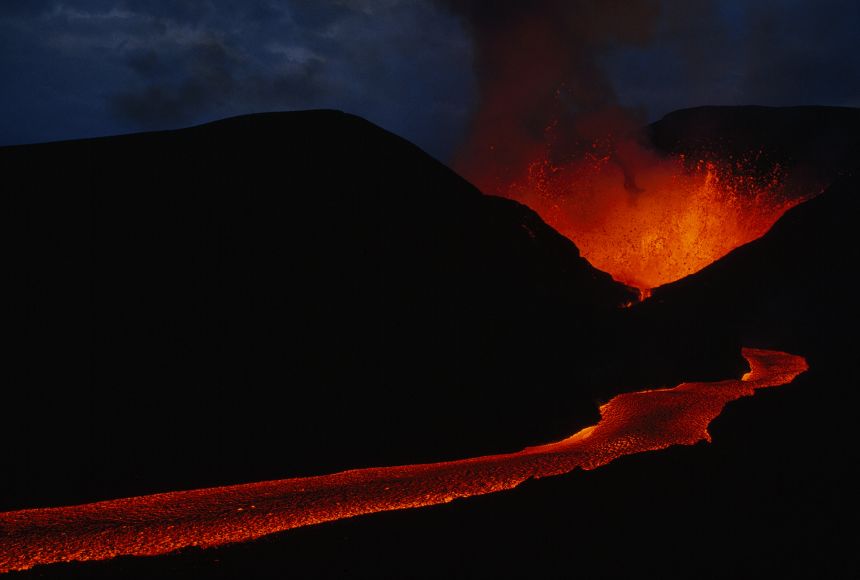
A volcano is an opening in a planet or moon’s crust through which molten rock, hot gases, and other materials erupt . Volcanoes often form a hill or mountain as layers of rock and ash build up from repeated eruptions .
Volcanoes are classified as active, dormant, or extinct. Active volcanoes have a recent history of eruptions ; they are likely to erupt again. Dormant volcanoes have not erupted for a very long time but may erupt at a future time. Extinct volcanoes are not expected to erupt in the future.
Inside an active volcano is a chamber in which molten rock, called magma , collects. Pressure builds up inside the magma chamber, causing the magma to move through channels in the rock and escape onto the planet’s surface. Once it flows onto the surface the magma is known as lava .
Some volcanic eruptions are explosive, while others occur as a slow lava flow. Eruptions can occur through a main opening at the top of the volcano or through vents that form on the sides. The rate and intensity of eruptions, as well as the composition of the magma, determine the shape of the volcano.
Volcanoes are found on both land and the ocean floor. When volcanoes erupt on the ocean floor, they often create underwater mountains and mountain ranges as the released lava cools and hardens. Volcanoes on the ocean floor become islands when the mountains become so large they rise above the surface of the ocean.
Media Credits
The audio, illustrations, photos, and videos are credited beneath the media asset, except for promotional images, which generally link to another page that contains the media credit. The Rights Holder for media is the person or group credited.
Production Managers
Program specialists, last updated.
October 19, 2023
User Permissions
For information on user permissions, please read our Terms of Service. If you have questions about how to cite anything on our website in your project or classroom presentation, please contact your teacher. They will best know the preferred format. When you reach out to them, you will need the page title, URL, and the date you accessed the resource.
If a media asset is downloadable, a download button appears in the corner of the media viewer. If no button appears, you cannot download or save the media.
Text on this page is printable and can be used according to our Terms of Service .
Interactives
Any interactives on this page can only be played while you are visiting our website. You cannot download interactives.
Related Resources

Volcanoes, explained
These fiery peaks have belched up molten rock, hot ash, and gas since Earth formed billions of years ago.
Volcanoes are Earth's geologic architects. They've created more than 80 percent of our planet's surface, laying the foundation that has allowed life to thrive. Their explosive force crafts mountains as well as craters. Lava rivers spread into bleak landscapes. But as time ticks by, the elements break down these volcanic rocks, liberating nutrients from their stony prisons and creating remarkably fertile soils that have allowed civilizations to flourish.
There are volcanoes on every continent, even Antarctica. Some 1,500 volcanoes are still considered potentially active around the world today; 161 of those—over 10 percent—sit within the boundaries of the United States .
But each volcano is different. Some burst to life in explosive eruptions, like the 1991 eruption of Mount Pinatubo , and others burp rivers of lava in what's known as an effusive eruption, like the 2018 activity of Hawaii's Kilauea volcano. These differences are all thanks to the chemistry driving the molten activity. Effusive eruptions are more common when the magma is less viscous, or runny, which allows gas to escape and the magma to flow down the volcano's slopes. Explosive eruptions, however, happen when viscous molten rock traps the gasses, building pressure until it violently breaks free.
How do volcanoes form?
The majority of volcanoes in the world form along the boundaries of Earth's tectonic plates—massive expanses of our planet's lithosphere that continually shift, bumping into one another. When tectonic plates collide, one often plunges deep below the other in what's known as a subduction zone .
As the descending landmass sinks deep into the Earth, temperatures and pressures climb, releasing water from the rocks. The water slightly reduces the melting point of the overlying rock, forming magma that can work its way to the surface—the spark of life to reawaken a slumbering volcano.
Not all volcanoes are related to subduction, however. Another way volcanoes can form is what's known as hotspot volcanism. In this situation, a zone of magmatic activity —or a hotspot—in the middle of a tectonic plate can push up through the crust to form a volcano. Although the hotspot itself is thought to be largely stationary, the tectonic plates continue their slow march, building a line of volcanoes or islands on the surface. This mechanism is thought to be behind the Hawaii volcanic chain .
Where are all these volcanoes?
Some 75 percent of the world's active volcanoes are positioned around the ring of fire , a 25,000-mile long, horseshoe-shaped zone that stretches from the southern tip of South America across the West Coast of North America, through the Bering Sea to Japan, and on to New Zealand.
LIMITED TIME OFFER
Receive up to 2 bonus issues, with any paid gift subscription!
This region is where the edges of the Pacific and Nazca plates butt up against an array of other tectonic plates. Importantly, however, the volcanoes of the ring aren't geologically connected . In other words, a volcanic eruption in Indonesia is not related to one in Alaska, and it could not stir the infamous Yellowstone supervolcano .
What are some of the dangers from a volcano?
Volcanic eruptions pose many dangers aside from lava flows. It's important to heed local authorities' advice during active eruptions and evacuate regions when necessary.
You May Also Like
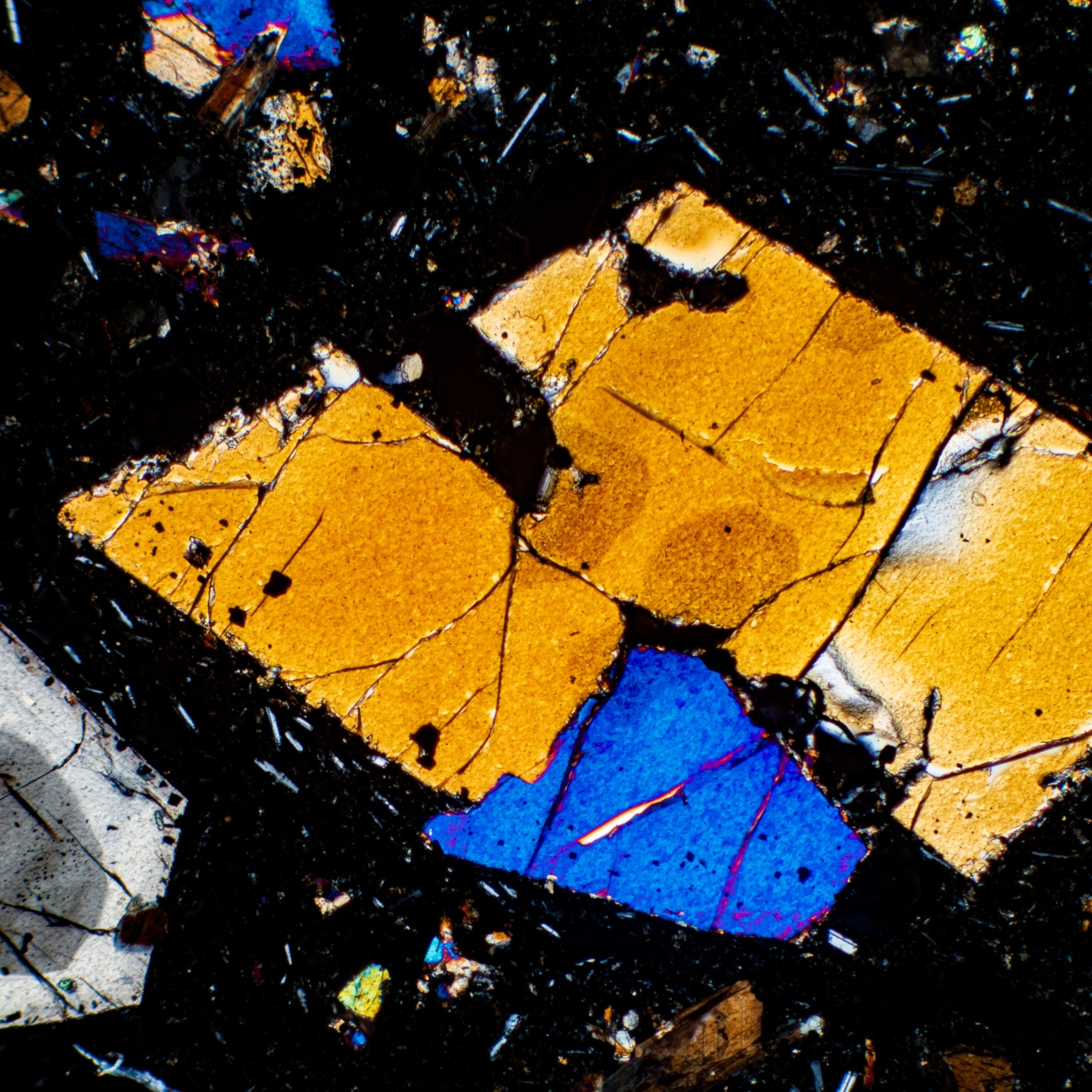
These crystal lava shards are ‘four dimensional videos’ of a volcano’s underworld

Iceland's latest eruption is quieting down—but the explosive upheaval isn't over yet
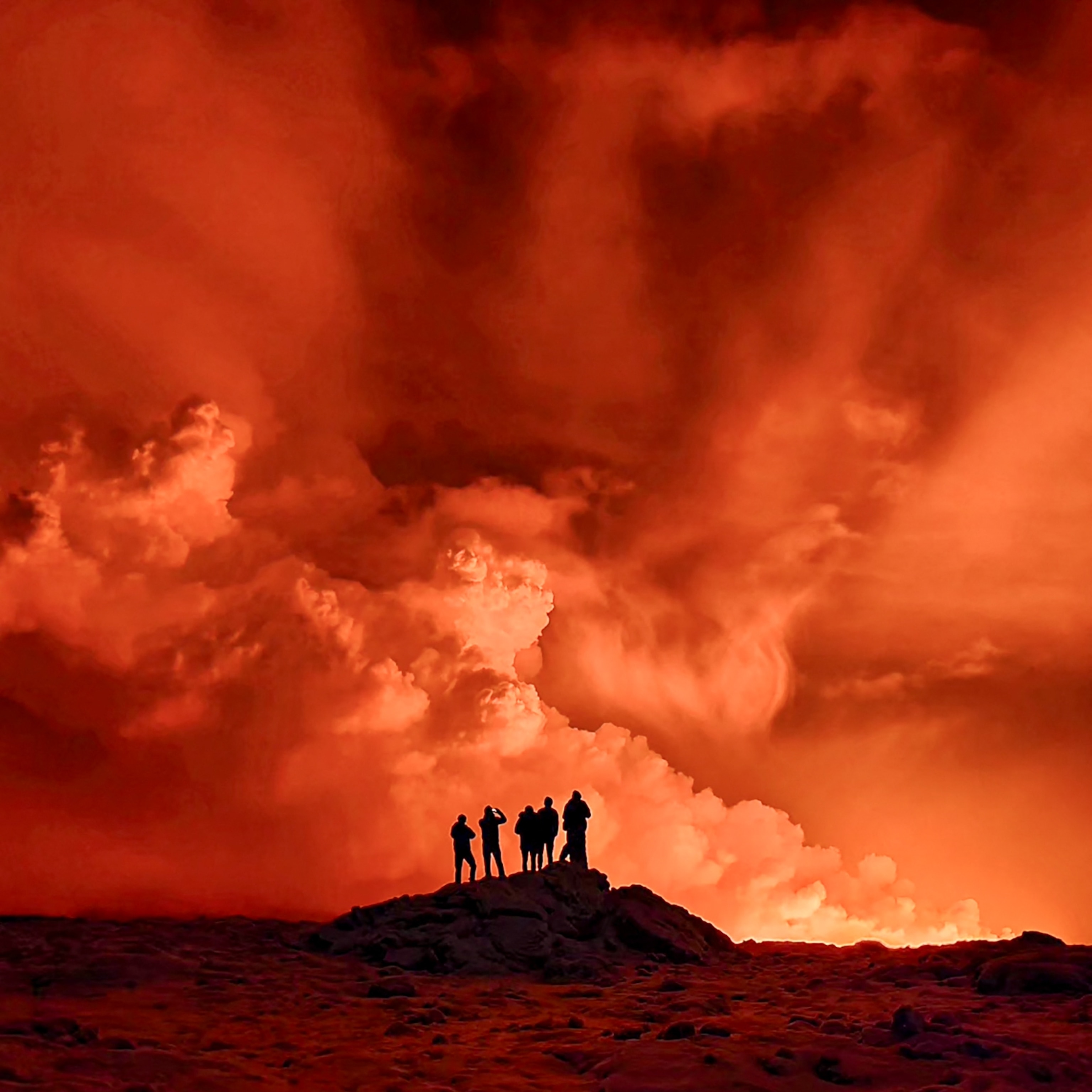
Why Iceland's latest eruption may be the most dangerous in recent history
One particular danger is pyroclastic flows, avalanches of hot rocks, ash, and toxic gas that race down slopes at speeds as high as 450 miles an hour . Such an event was responsible for wiping out the people of Pompeii and Herculaneum after Mount Vesuvius erupted in A.D. 79 .
Similarly, volcanic mudflows called lahars can be very destructive. These fast-flowing waves of mud and debris can race down a volcano's flanks, burying entire towns.
Ash is another volcanic danger. Unlike the soft, fluffy bits of charred wood left after a campfire, volcanic ash is made of sharp fragments of rocks and volcanic glass each less than two millimeters across. The ash forms as the gasses within rising magma expand, shattering the cooling rocks as they burst from the volcano's mouth. It's not only dangerous to inhale , it's heavy and builds up quickly. Volcanic ash can collapse weak structures, cause power outages, and is a challenge to shovel away post-eruption.
Can we predict volcanic eruptions?
Volcanoes give some warning of pending eruption, making it vital for scientists to closely monitor any volcanoes near large population centers. Warning signs include small earthquakes, swelling or bulging of the volcano's sides, and increased emission of gasses from its vents. None of those signs necessarily mean an eruption is imminent, but they can help scientists evaluate the state of the volcano when magma is building.
However, it's impossible to say exactly when, or even if, any given volcano will erupt. Volcanoes don't run on a timetable like a train. This means it's impossible for one to be “overdue” for eruption —no matter what news headlines say.
What is the largest eruption in history?
The deadliest eruption in recorded history was the 1815 explosion of Mount Tabora in Indonesia. The blast was one of the most powerful ever documented and created a caldera —essentially a crater—4 miles across and more than 3,600 feet deep. A superheated plume of hot ash and gas shot 28 miles into the sky, producing numerous pyroclastic flows when it collapsed.
The eruption and its immediate dangers killed around 10,000 people. But that wasn't its only impact. The volcanic ash and gas injected into the atmosphere obscured the sun and increased the reflectivity of Earth, cooling its surface and causing what's known as the year without a summer. Starvation and disease during this time killed some 82,000 more people, and the gloomy conditions are often credited as the inspiration for gothic horror tales, such as Mary Shelley's Frankenstein .
Although there have been several big eruptions in recorded history, volcanic eruptions today are no more frequent than there were a decade or even a century ago. At least a dozen volcanoes erupt on any given day. As monitoring capacity for—and interest in—volcanic eruptions increases, coverage of the activity more frequently appears in the news and on social media. As Erik Klemetti, associate professor of geosciences at Denison University, writes in The Washington Post : “The world is not more volcanically active, we’re just more volcanically aware.”
Related Topics
- VOLCANIC ERUPTIONS

Volcanoes don’t just erupt on schedule—but they have been in Iceland

Startling volcanic activity has town in Iceland bracing for crisis

A huge volcano near Naples has been convulsing. What does it mean?

Mysteries lurk below Iceland's restless volcanoes
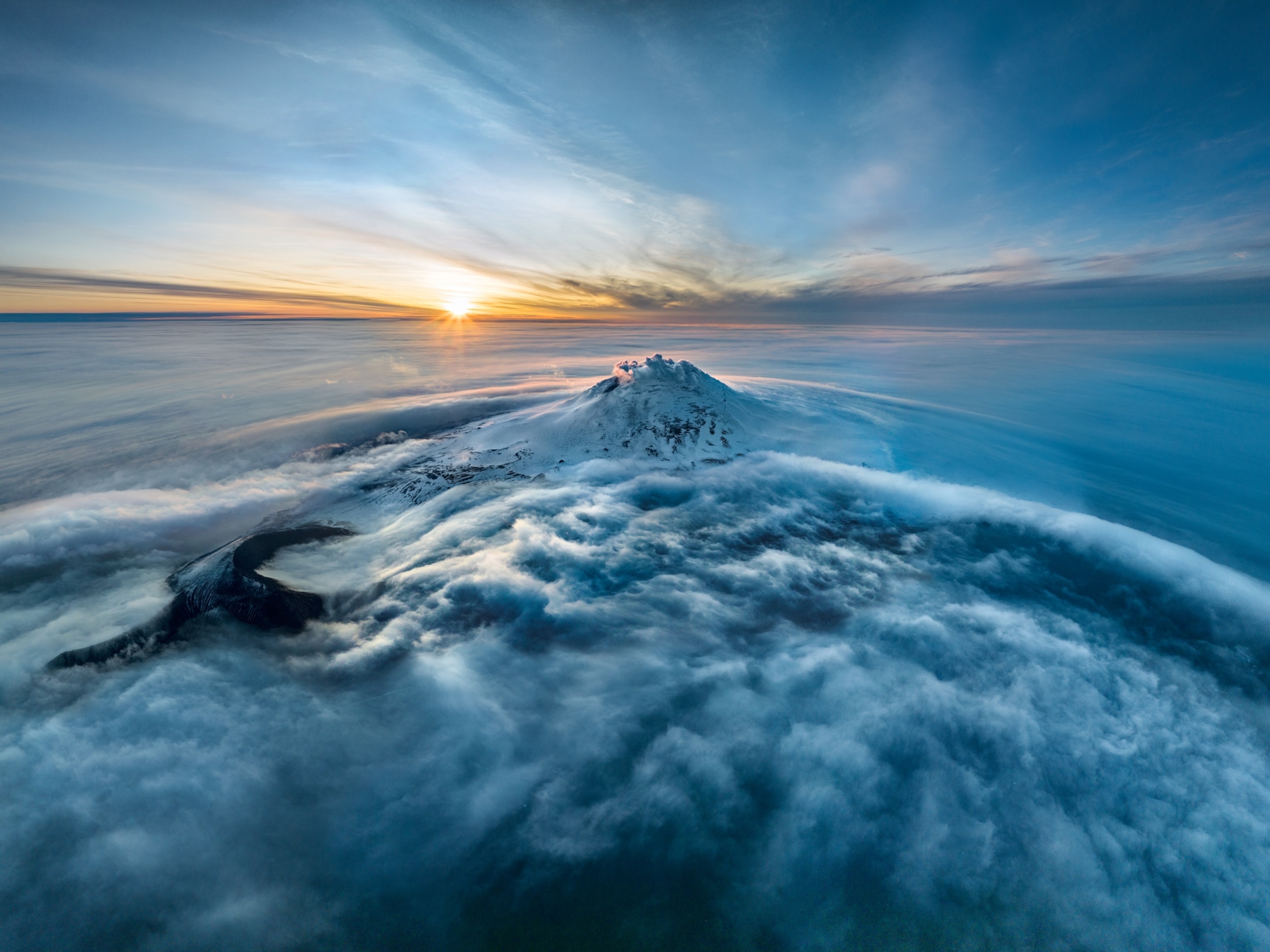
The world’s loneliest volcano may hold something truly rare. We went to find it.
- History & Culture
- Photography
- Environment
- Paid Content

History & Culture
- Mind, Body, Wonder
- Terms of Use
- Privacy Policy
- Your US State Privacy Rights
- Children's Online Privacy Policy
- Interest-Based Ads
- About Nielsen Measurement
- Do Not Sell or Share My Personal Information
- Nat Geo Home
- Attend a Live Event
- Book a Trip
- Inspire Your Kids
- Shop Nat Geo
- Visit the D.C. Museum
- Learn About Our Impact
- Support Our Mission
- Advertise With Us
- Customer Service
- Renew Subscription
- Manage Your Subscription
- Work at Nat Geo
- Sign Up for Our Newsletters
- Contribute to Protect the Planet
Copyright © 1996-2015 National Geographic Society Copyright © 2015-2024 National Geographic Partners, LLC. All rights reserved

Volcanic Eruptions and Their Repose, Unrest, Precursors, and Timing (2017)
Chapter: 1 introduction, 1 introduction.
Volcanoes are a key part of the Earth system. Most of Earth’s atmosphere, water, and crust were delivered by volcanoes, and volcanoes continue to recycle earth materials. Volcanic eruptions are common. More than a dozen are usually erupting at any time somewhere on Earth, and close to 100 erupt in any year ( Loughlin et al., 2015 ).
Volcano landforms and eruptive behavior are diverse, reflecting the large number and complexity of interacting processes that govern the generation, storage, ascent, and eruption of magmas. Eruptions are influenced by the tectonic setting, the properties of Earth’s crust, and the history of the volcano. Yet, despite the great variability in the ways volcanoes erupt, eruptions are all governed by a common set of physical and chemical processes. Understanding how volcanoes form, how they erupt, and their consequences requires an understanding of the processes that cause rocks to melt and change composition, how magma is stored in the crust and then rises to the surface, and the interaction of magma with its surroundings. Our understanding of how volcanoes work and their consequences is also shared with the millions of people who visit U.S. volcano national parks each year.
Volcanoes have enormous destructive power. Eruptions can change weather patterns, disrupt climate, and cause widespread human suffering and, in the past, mass extinctions. Globally, volcanic eruptions caused about 80,000 deaths during the 20th century ( Sigurdsson et al., 2015 ). Even modest eruptions, such as the 2010 Eyjafjallajökull eruption in Iceland, have multibillion-dollar global impacts through disruption of air traffic. The 2014 steam explosion at Mount Ontake, Japan, killed 57 people without any magma reaching the surface. Many volcanoes in the United States have the potential for much larger eruptions, such as the 1912 eruption of Katmai, Alaska, the largest volcanic eruption of the 20th century ( Hildreth and Fierstein, 2012 ). The 2008 eruption of the unmonitored Kasatochi volcano, Alaska, distributed volcanic gases over most of the continental United States within a week ( Figure 1.1 ).
Finally, volcanoes are important economically. Volcanic heat provides low-carbon geothermal energy. U.S. generation of geothermal energy accounts for nearly one-quarter of the global capacity ( Bertani, 2015 ). In addition, volcanoes act as magmatic and hydrothermal distilleries that create ore deposits, including gold and copper ores.
Moderate to large volcanic eruptions are infrequent yet high-consequence events. The impact of the largest possible eruption, similar to the super-eruptions at Yellowstone, Wyoming; Long Valley, California; or Valles Caldera, New Mexico, would exceed that of any other terrestrial natural event. Volcanoes pose the greatest natural hazard over time scales of several decades and longer, and at longer time scales they have the potential for global catastrophe ( Figure 1.2 ). While
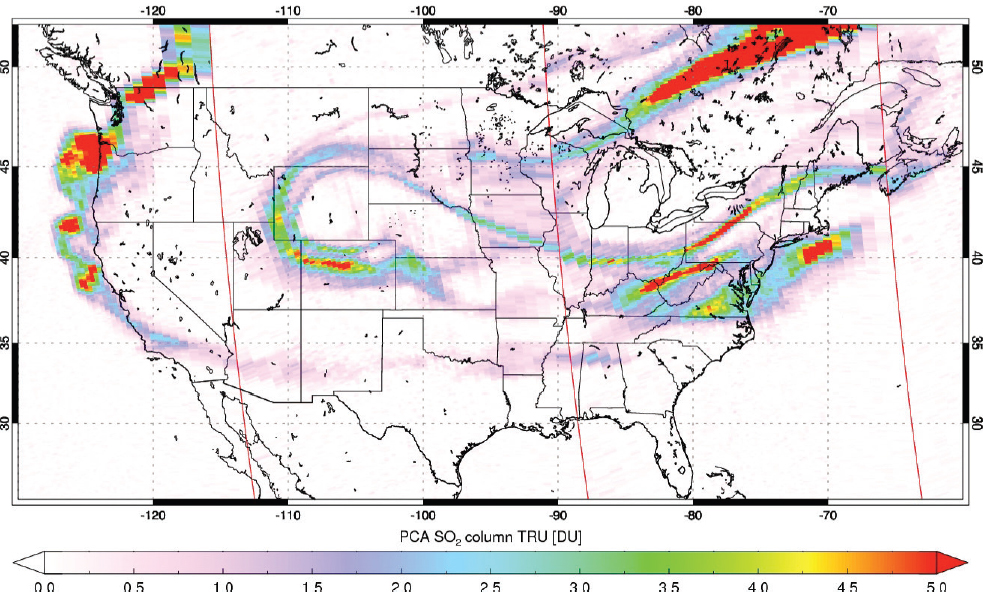
the continental United States has not suffered a fatal eruption since 1980 at Mount St. Helens, the threat has only increased as more people move into volcanic areas.
Volcanic eruptions evolve over very different temporal and spatial scales than most other natural hazards ( Figure 1.3 ). In particular, many eruptions are preceded by signs of unrest that can serve as warnings, and an eruption itself often persists for an extended period of time. For example, the eruption of Kilauea Volcano in Hawaii has continued since 1983. We also know the locations of many volcanoes and, hence, where most eruptions will occur. For these reasons, the impacts of at least some types of volcanic eruptions should be easier to mitigate than other natural hazards.
Anticipating the largest volcanic eruptions is possible. Magma must rise to Earth’s surface and this movement is usually accompanied by precursors—changes in seismic, deformation, and geochemical signals that can be recorded by ground-based and space-borne instruments. However, depending on the monitoring infrastructure, precursors may present themselves over time scales that range from a few hours (e.g., 2002 Reventador, Ecuador, and 2015 Calbuco, Chile) to decades before eruption (e.g., 1994 Rabaul, Papua New Guinea). Moreover, not all signals of volcanic unrest are immediate precursors to surface eruptions (e.g., currently Long Valley, California, and Campi Flegrei, Italy).
Probabilistic forecasts account for this uncertainty using all potential eruption scenarios and all relevant data. An important consideration is that the historical record is short and biased. The instrumented record is even shorter and, for most volcanoes, spans only the last few decades—a miniscule fraction of their lifetime. Knowledge can be extended qualitatively using field studies of volcanic deposits, historical accounts, and proxy data, such as ice and marine sediment cores and speleothem (cave) records. Yet, these too are biased because they commonly do not record small to moderate eruptions.
Understanding volcanic eruptions requires contributions from a wide range of disciplines and approaches. Geologic studies play a critical role in reconstructing the past eruption history of volcanoes,
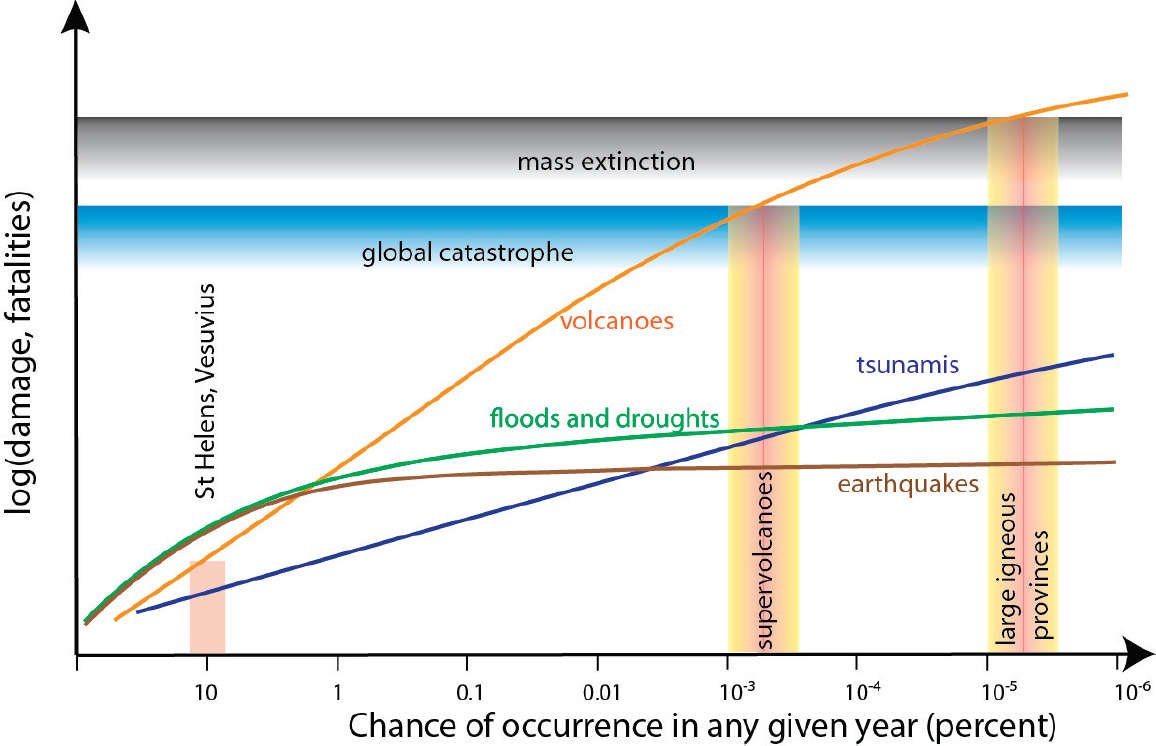
especially of the largest events, and in regions with no historical or directly observed eruptions. Geochemical and geophysical techniques are used to study volcano processes at scales ranging from crystals to plumes of volcanic ash. Models reveal essential processes that control volcanic eruptions, and guide data collection. Monitoring provides a wealth of information about the life cycle of volcanoes and vital clues about what kind of eruption is likely and when it may occur.
1.1 OVERVIEW OF THIS REPORT
At the request of managers at the National Aeronautics and Space Administration (NASA), the National Science Foundation, and the U.S. Geological Survey (USGS), the National Academies of Sciences, Engineering, and Medicine established a committee to undertake the following tasks:
- Summarize current understanding of how magma is stored, ascends, and erupts.
- Discuss new disciplinary and interdisciplinary research on volcanic processes and precursors that could lead to forecasts of the type, size, and timing of volcanic eruptions.
- Describe new observations or instrument deployment strategies that could improve quantification of volcanic eruption processes and precursors.
- Identify priority research and observations needed to improve understanding of volcanic eruptions and to inform monitoring and early warning efforts.

The roles of the three agencies in advancing volcano science are summarized in Box 1.1 .
The committee held four meetings, including an international workshop, to gather information, deliberate, and prepare its report. The report is not intended to be a comprehensive review, but rather to provide a broad overview of the topics listed above. Chapter 2 addresses the opportunities for better understanding the storage, ascent, and eruption of magmas. Chapter 3 summarizes the challenges and prospects for forecasting eruptions and their consequences. Chapter 4 highlights repercussions of volcanic eruptions on a host of other Earth systems. Although not explicitly called out in the four tasks, the interactions between volcanoes and other Earth systems affect the consequences of eruptions, and offer opportunities to improve forecasting and obtain new insights into volcanic processes. Chapter 5 summarizes opportunities to strengthen
research in volcano science. Chapter 6 provides overarching conclusions. Supporting material appears in appendixes, including a list of volcano databases (see Appendix A ), a list of workshop participants (see Appendix B ), biographical sketches of the committee members (see Appendix C ), and a list of acronyms and abbreviations (see Appendix D ).
Background information on these topics is summarized in the rest of this chapter.
1.2 VOLCANOES IN THE UNITED STATES
The USGS has identified 169 potentially active volcanoes in the United States and its territories (e.g., Marianas), 55 of which pose a high threat or very high threat ( Ewert et al., 2005 ). Of the total, 84 are monitored by at least one seismometer, and only 3 have gas sensors (as of November 2016). 1 Volcanoes are found in the Cascade mountains, Aleutian arc, Hawaii, and the western interior of the continental United States ( Figure 1.4 ). The geographical extent and eruption hazards of these volcanoes are summarized below.
The Cascade volcanoes extend from Lassen Peak in northern California to Mount Meager in British Columbia. The historical record contains only small- to moderate-sized eruptions, but the geologic record reveals much larger eruptions ( Carey et al., 1995 ; Hildreth, 2007 ). Activity tends to be sporadic ( Figure 1.5 ). For example, nine Cascade eruptions occurred in the 1850s, but none occurred between 1915 and 1980, when Mount St. Helens erupted. Consequently, forecasting eruptions in the Cascades is subject to considerable uncertainty. Over the coming decades, there may be multiple eruptions from several volcanoes or no eruptions at all.
The Aleutian arc extends 2,500 km across the North Pacific and comprises more than 130 active and potentially active volcanoes. Although remote, these volcanoes pose a high risk to overflying aircraft that carry more than 30,000 passengers a day, and are monitored by a combination of ground- and space-based sensors. One or two small to moderate explosive eruptions occur in the Aleutians every year, and very large eruptions occur less frequently. For example, the world’s largest eruption of the 20th century occurred approximately 300 miles from Anchorage, in 1912.
In Hawaii, Kilauea has been erupting largely effusively since 1983, but the location and nature of eruptions can vary dramatically, presenting challenges for disaster preparation. The population at risk from large-volume, rapidly moving lava flows on the flanks of the Mauna Loa volcano has grown tremendously in the past few decades ( Dietterich and Cashman, 2014 ), and few island residents are prepared for the even larger magnitude explosive eruptions that are documented in the last 500 years ( Swanson et al., 2014 ).
All western states have potentially active volcanoes, from New Mexico, where lava flows have reached within a few kilometers of the Texas and Oklahoma borders ( Fitton et al., 1991 ), to Montana, which borders the Yellowstone caldera ( Christiansen, 1984 ). These volcanoes range from immense calderas that formed from super-eruptions ( Mastin et al., 2014 ) to small-volume basaltic volcanic fields that erupt lava flows and tephra for a few months to a few decades. Some of these eruptions are monogenic (erupt just once) and pose a special challenge for forecasting. Rates of activity in these distributed volcanic fields are low, with many eruptions during the past few thousand years (e.g., Dunbar, 1999 ; Fenton, 2012 ; Laughlin et al., 1994 ), but none during the past hundred years.
1.3 THE STRUCTURE OF A VOLCANO
Volcanoes often form prominent landforms, with imposing peaks that tower above the surrounding landscape, large depressions (calderas), or volcanic fields with numerous dispersed cinder cones, shield volcanoes, domes, and lava flows. These various landforms reflect the plate tectonic setting, the ways in which those volcanoes erupt, and the number of eruptions. Volcanic landforms change continuously through the interplay between constructive processes such as eruption and intrusion, and modification by tectonics, climate, and erosion. The stratigraphic and structural architecture of volcanoes yields critical information on eruption history and processes that operate within the volcano.
Beneath the volcano lies a magmatic system that in most cases extends through the crust, except during eruption. Depending on the setting, magmas may rise
___________________
1 Personal communication from Charles Mandeville, Program Coordinator, Volcano Hazards Program, U.S. Geological Survey, on November 26, 2016.
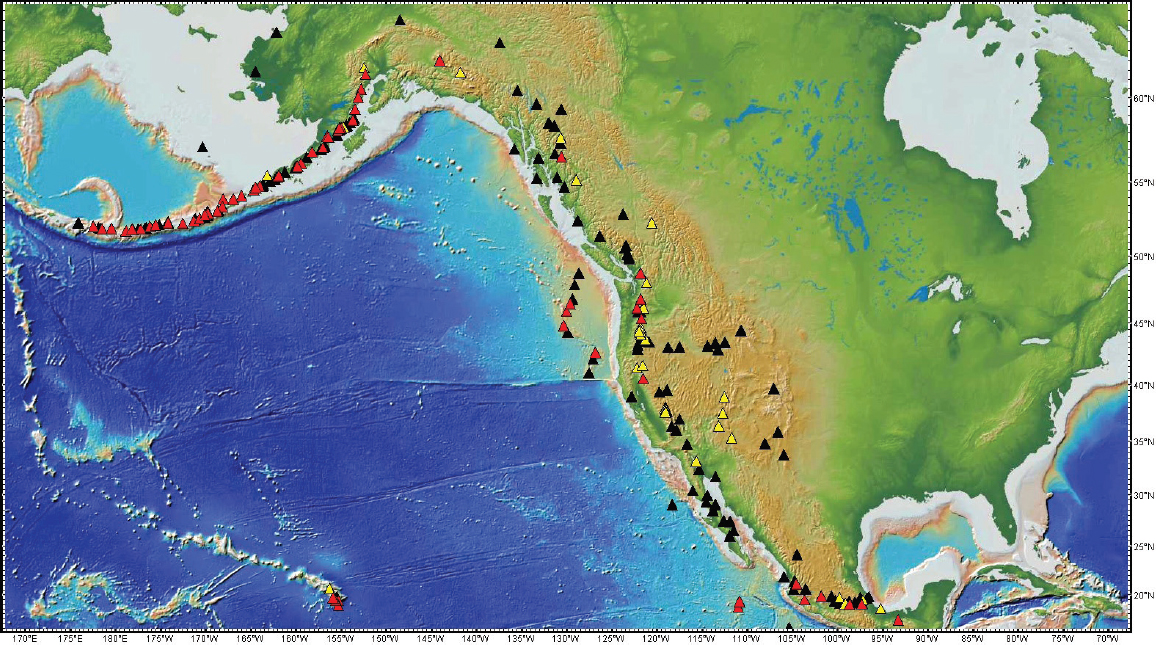
directly from the mantle or be staged in one or more storage regions within the crust before erupting. The uppermost part (within 2–3 km of Earth’s surface) often hosts an active hydrothermal system where meteoric groundwater mingles with magmatic volatiles and is heated by deeper magma. Identifying the extent and vigor of hydrothermal activity is important for three reasons: (1) much of the unrest at volcanoes occurs in hydrothermal systems, and understanding the interaction of hydrothermal and magmatic systems is important for forecasting; (2) pressure buildup can cause sudden and potentially deadly phreatic explosions from the hydrothermal system itself (such as on Ontake, Japan, in 2014), which, in turn, can influence the deeper magmatic system; and (3) hydrothermal systems are energy resources and create ore deposits.
Below the hydrothermal system lies a magma reservoir where magma accumulates and evolves prior to eruption. Although traditionally modeled as a fluid-filled cavity, there is growing evidence that magma reservoirs may comprise an interconnected complex of vertical and/or horizontal magma-filled cracks, or a partially molten mush zone, or interleaved lenses of magma and solid material ( Cashman and Giordano, 2014 ). In arc volcanoes, magma chambers are typically located 3–6 km below the surface. The magma chamber is usually connected to the surface via a fluid-filled conduit only during eruptions. In some settings, magma may ascend directly from the mantle without being stored in the crust.
In the broadest sense, long-lived magma reservoirs comprise both eruptible magma (often assumed to contain less than about 50 percent crystals) and an accumulation of crystals that grow along the margins or settle to the bottom of the magma chamber. Physical segregation of dense crystals and metals can cause the floor of the magma chamber to sag, a process balanced by upward migration of more buoyant melt. A long-lived magma chamber can thus become increasingly stratified in composition and density.
The deepest structure beneath volcanoes is less well constrained. Swarms of low-frequency earthquakes at mid- to lower-crustal depths (10–40 km) beneath volcanoes suggest that fluid is periodically transferred into the base of the crust ( Power et al., 2004 ). Tomographic studies reveal that active volcanic systems have deep crustal roots that contain, on average, a small fraction of melt, typically less than 10 percent. The spatial distribution of that melt fraction, particularly how much is concentrated in lenses or in larger magma bodies, is unknown. Erupted samples preserve petrologic and geochemical evidence of deep crystallization, which requires some degree of melt accumulation. Seismic imaging and sparse outcrops suggest that the proportion of unerupted solidified magma relative to the surrounding country rock increases with depth and that the deep roots of volcanoes are much more extensive than their surface expression.
1.4 MONITORING VOLCANOES
Volcano monitoring is critical for hazard forecasts, eruption forecasts, and risk mitigation. However, many volcanoes are not monitored at all, and others are monitored using only a few types of instruments. Some parameters, such as the mass, extent, and trajectory of a volcanic ash cloud, are more effectively measured by satellites. Other parameters, notably low-magnitude earthquakes and volcanic gas emissions that may signal an impending eruption, require ground-based monitoring on or close to the volcanic edifice. This section summarizes existing and emerging technologies for monitoring volcanoes from the ground and from space.
Monitoring Volcanoes on or Near the Ground
Ground-based monitoring provides data on the location and movement of magma. To adequately capture what is happening inside a volcano, it is necessary to obtain a long-term and continuous record, with periods spanning both volcanic quiescence and periods of unrest. High-frequency data sampling and efficient near-real-time relay of information are important, especially when processes within the volcano–magmatic–hydrothermal system are changing rapidly. Many ground-based field campaigns are time intensive and can be hazardous when volcanoes are active. In these situations, telemetry systems permit the safe and continuous collection of data, although the conditions can be harsh and the lifetime of instruments can be limited in these conditions.
Ground-based volcano monitoring falls into four broad categories: seismic, deformation, gas, and thermal monitoring ( Table 1.1 ). Seismic monitoring tools,
TABLE 1.1 Ground-Based Instrumentation for Monitoring Volcanoes
including seismometers and infrasound sensors, are used to detect vibrations caused by breakage of rock and movement of fluids and to assess the evolution of eruptive activity. Ambient seismic noise monitoring can image subsurface reservoirs and document changes in wave speed that may reflect stress. changes. Deformation monitoring tools, including tiltmeters, borehole strainmeters, the Global Navigation Satellite System (GNSS, which includes the Global Positioning System [GPS]), lidar, radar, and gravimeters, are used to detect the motion of magma and other fluids in the subsurface. Some of these tools, such as GNSS and lidar, are also used to detect erupted products, including ash clouds, pyroclastic density currents, and volcanic bombs. Gas monitoring tools, including a range of sensors ( Table 1.1 ), and direct sampling of gases and fluids are used to detect magma intrusions and changes in magma–hydrothermal interactions. Thermal monitoring tools, such as infrared cameras, are used to detect dome growth and lava breakouts. Continuous video or photographic observations are also commonly used and, despite their simplicity, most directly document volcanic activity. Less commonly used monitoring technologies, such as self-potential, electromagnetic techniques, and lightning detection are used to constrain fluid movement and to detect
ash clouds. In addition, unmanned aerial vehicles (e.g., aircraft and drones) are increasingly being used to collect data. Rapid sample collection and analysis is also becoming more common as a monitoring tool at volcano observatories. A schematic of ground-based monitoring techniques is shown in Figure 1.6 .
Monitoring Volcanoes from Space
Satellite-borne sensors and instruments provide synoptic observations during volcanic eruptions when collecting data from the ground is too hazardous or where volcanoes are too remote for regular observation. Repeat-pass data collected over years or decades provide a powerful means for detecting surface changes on active volcanoes. Improvements in instrument sensitivity, data availability, and the computational capacity required to process large volumes of data have led to a dramatic increase in “satellite volcano science.”
Although no satellite-borne sensor currently in orbit has been specifically designed for volcano monitoring, a number of sensors measure volcano-relevant
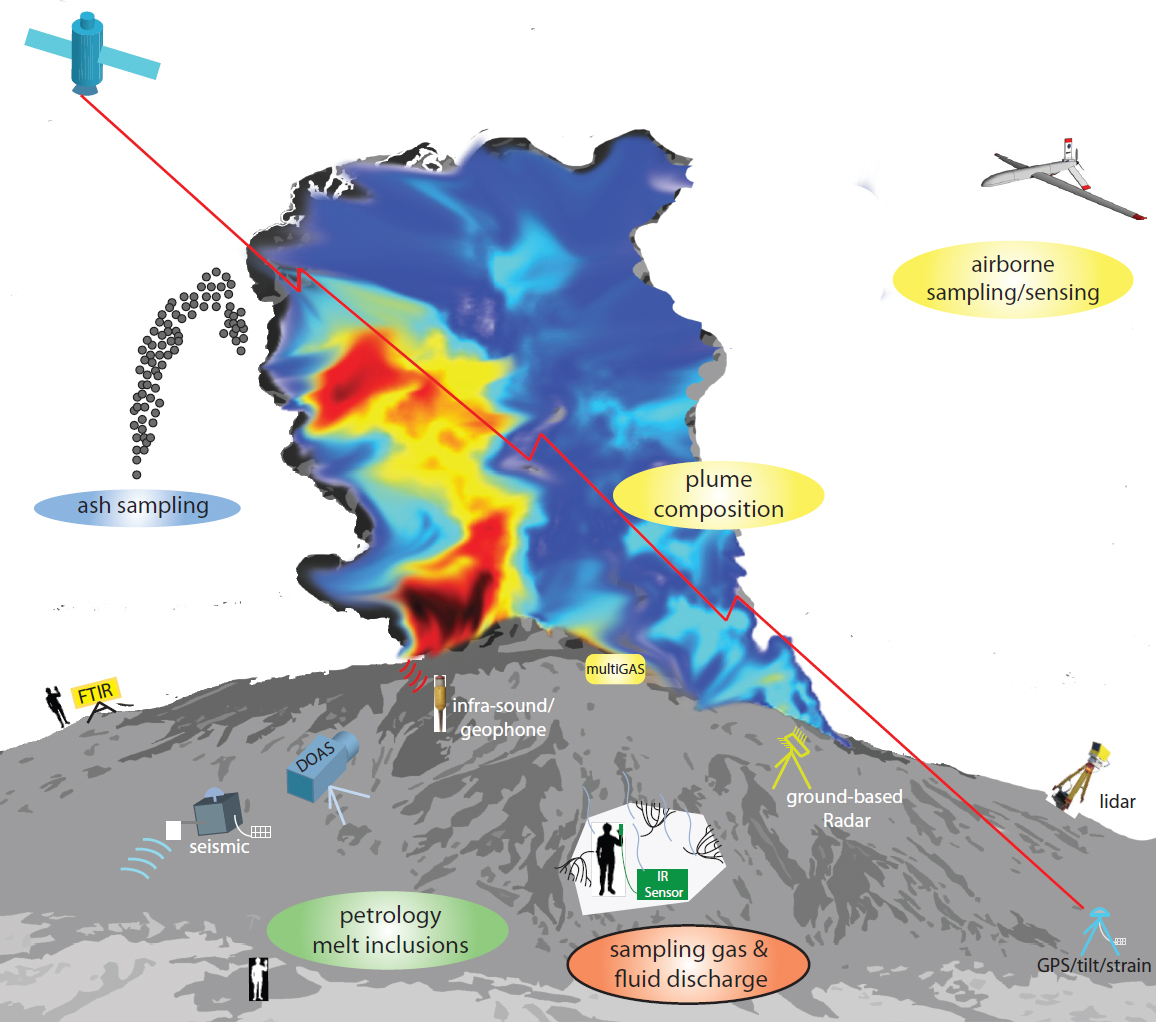
TABLE 1.2 Satellite-Borne Sensor Suite for Volcano Monitoring
NOTE: AIRS, Atmospheric Infrared Sounder; ALOS, Advanced Land Observing Satellite; ASTER, Advanced Spaceborne Thermal Emission and Reflection Radiometer; AVHRR, Advanced Very High Resolution Radiometer; CALIPSO, Cloud-Aerosol Lidar and Infrared Pathfinder Satellite Observation; COSMO-SkyMed, Constellation of Small Satellites for Mediterranean Basin Observation; GOES, Geostationary Operational Environmental Satellite; IASI, Infrared Atmospheric Sounding Interferometer; MISR, Multi-angle Imaging SpectroRadiometer; MLS, Microwave Limb Sounder; MODIS, Moderate Resolution Imaging Spectroradiometer; OMI, Ozone Monitoring Instrument; OMPS, Ozone Mapping and Profiler Suite; SAGE, Stratospheric Aerosol and Gas Experiment.
parameters, including heat flux, gas and ash emissions, and deformation ( Table 1.2 ). Thermal infrared data are used to detect eruption onset and cessation, calculate lava effusion rates, map lava flows, and estimate ash column heights during explosive eruptions. In some cases, satellites may capture thermal precursors to eruptions, although low-temperature phenomena are challenging to detect. Both high-temporal/low-spatial-resolution (geostationary orbit) and high-spatial/low-temporal-resolution (polar orbit) thermal infrared observations are needed for global volcano monitoring.
Satellite-borne sensors are particularly effective for observing the emission and dispersion of volcanic gas and ash plumes in the atmosphere. Although several volcanic gas species can be detected from space (including SO 2 , BrO, OClO, H 2 S, HCl, and CO; Carn et al., 2016 ), SO 2 is the most readily measured, and it is also responsible for much of the impact of eruptions on climate. Satellite measurements of SO 2 are valuable for detecting eruptions, estimating global volcanic fluxes and recycling of other volatile species, and tracking volcanic clouds that may be hazardous to aviation in near real time. Volcanic ash cloud altitude is most accurately determined by spaceborne lidar, although spatial coverage is limited. Techniques for measuring volcanic CO 2 from space are under development and could lead to earlier detection of preeruptive volcanic degassing.
Interferometric synthetic aperture radar (InSAR) enables global-scale background monitoring of volcano deformation ( Figure 1.7 ). InSAR provides much higher spatial resolution than GPS, but lower accuracy and temporal resolution. However, orbit repeat times will diminish as more InSAR missions are launched, such as the European Space Agency’s recently deployed Sentinel-1 satellite and the NASA–Indian Space Research Organisation synthetic aperture radar mission planned for launch in 2020.
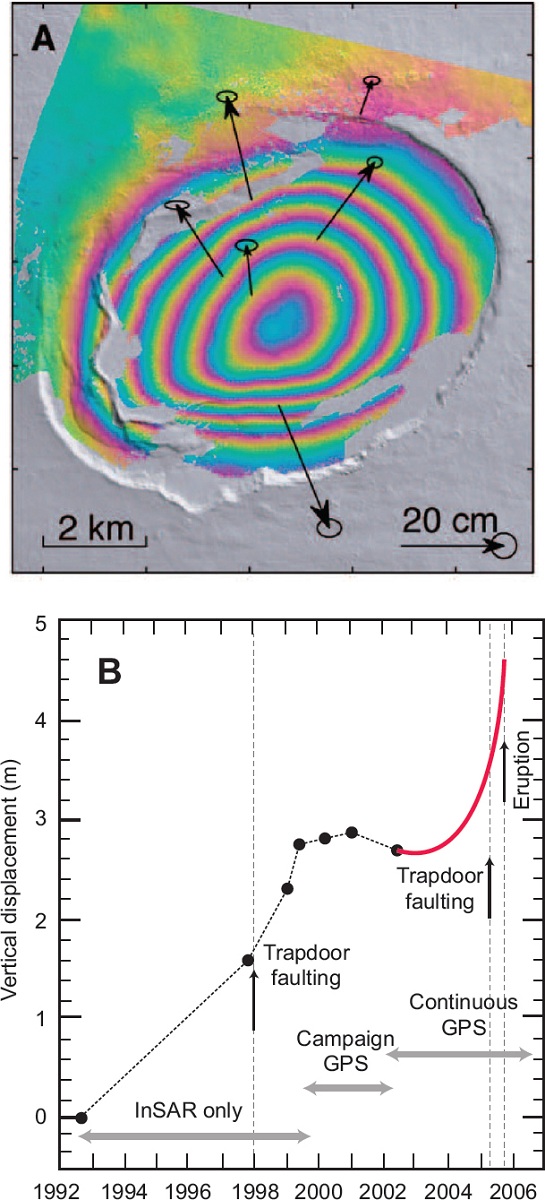
1.5 ERUPTION BEHAVIOR
Eruptions range from violently explosive to gently effusive, from short lived (hours to days) to persistent over decades or centuries, from sustained to intermittent, and from steady to unsteady ( Siebert et al., 2015 ). Eruptions may initiate from processes within the magmatic system ( Section 1.3 ) or be triggered by processes and properties external to the volcano, such as precipitation, landslides, and earthquakes. The eruption behavior of a volcano may change over time. No classification scheme captures this full diversity of behaviors (see Bonadonna et al., 2016 ), but some common schemes to describe the style, magnitude, and intensity of eruptions are summarized below.
Eruption Magnitude and Intensity
The size of eruptions is usually described in terms of total erupted mass (or volume), often referred to as magnitude, and mass eruption rate, often referred to as intensity. Pyle (2015) quantified magnitude and eruption intensity as follows:
magnitude = log 10 (mass, in kg) – 7, and
intensity = log 10 (mass eruption rate, in kg/s) + 3.
The Volcano Explosivity Index (VEI) introduced by Newhall and Self (1982) assigns eruptions to a VEI class based primarily on measures of either magnitude (erupted mass or volume) or intensity (mass eruption rate and/or eruption plume height), with more weight given to magnitude. The VEI classes are summarized in Figure 1.8 . The VEI classification is still in use, despite its many limitations, such as its reliance on only a few types of measurements and its poor fit for small to moderate eruptions (see Bonadonna et al., 2016 ).
Smaller VEI events are relatively common, whereas larger VEI events are exponentially less frequent ( Siebert et al., 2015 ). For example, on average about three VEI 3 eruptions occur each year, whereas there is a 5 percent chance of a VEI 5 eruption and a 0.2 percent chance of a VEI 7 (e.g., Crater Lake, Oregon) event in any year.
Eruption Style
The style of an eruption encompasses factors such as eruption duration and steadiness, magnitude, gas flux, fountain or column height, and involvement of magma and/or external source of water (phreatic and phreatomagmatic eruptions). Eruptions are first divided into effusive (lava producing) and explosive (pyroclast producing) styles, although individual eruptions can be simultaneously effusive and weakly explosive, and can pass rapidly and repeatedly between eruption styles. Explosive eruptions are further subdivided into styles that are sustained on time scales of hours to days and styles that are short lived ( Table 1.3 ).
Classification of eruption style is often qualitative and based on historical accounts of characteristic eruptions from type-volcanoes. However, many type-volcanoes exhibit a range of eruption styles over time (e.g., progressing between Strombolian, Vulcanian, and Plinian behavior; see Fee et al., 2010 ), which has given rise to terms such as subplinian or violent Strombolian.
1.6 ERUPTION HAZARDS
Eruption hazards are diverse ( Figure 1.9 ) and may extend more than thousands of kilometers from an active volcano. From the perspective of risk and impact, it is useful to distinguish between near-source and distal hazards. Near-source hazards are far more unpredictable than distal hazards.
Near-source hazards include those that are airborne, such as tephra fallout, volcanic gases, and volcanic projectiles, and those that are transported laterally on or near the ground surface, such as pyroclastic density currents, lava flows, and lahars. Pyroclastic density currents are hot volcanic flows containing mixtures of gas and micron- to meter-sized volcanic particles. They can travel at velocities exceeding 100 km per hour. The heat combined with the high density of material within these flows obliterates objects in their path, making them the most destructive of volcanic hazards. Lava flows also destroy everything in their path, but usually move slowly enough to allow people to get out of the way. Lahars are mixtures of volcanic debris, sediment, and water that can travel many tens of kilometers along valleys and river channels. They may be triggered during an eruption by interaction between volcanic prod-
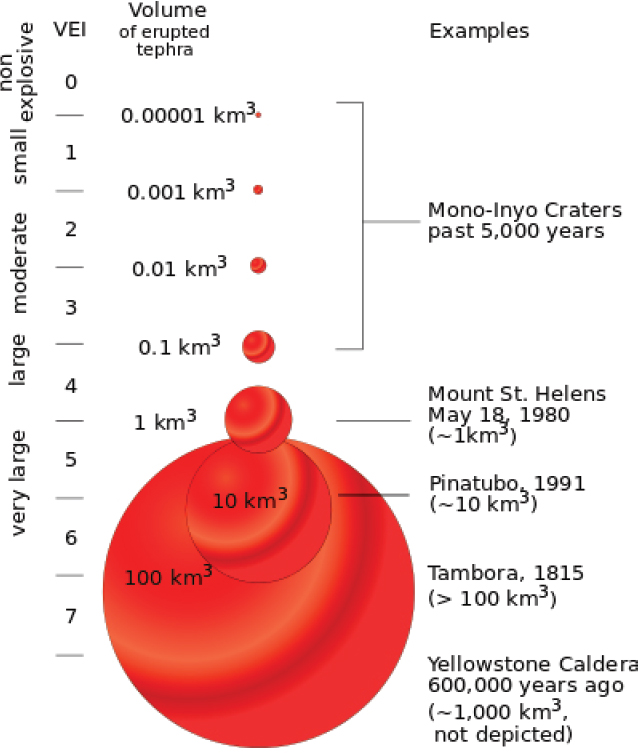
TABLE 1.3 Characteristics of Different Eruption Styles
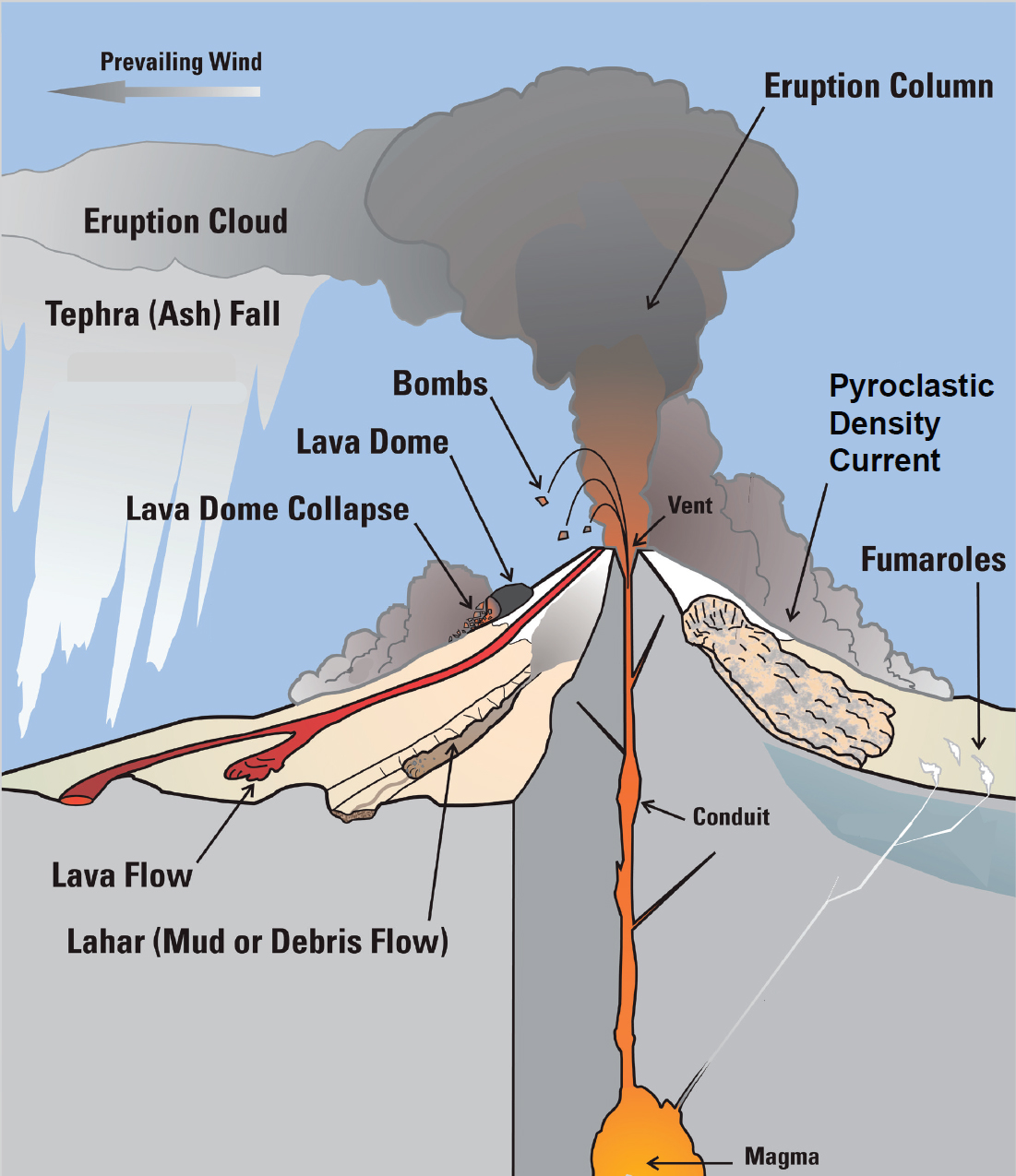
ucts and snow, ice, rain, or groundwater. Lahars can be more devastating than the eruption itself. Ballistic blocks are large projectiles that typically fall within 1–5 km from vents.
The largest eruptions create distal hazards. Explosive eruptions produce plumes that are capable of dispersing ash hundreds to thousands of kilometers from the volcano. The thickness of ash deposited depends on the intensity and duration of the eruption and the wind direction. Airborne ash and ash fall are the most severe distal hazards and are likely to affect many more people than near-source hazards. They cause respiratory problems and roof collapse, and also affect transport networks and infrastructure needed to support emergency response. Volcanic ash is a serious risk to air traffic. Several jets fully loaded with passengers have temporarily lost power on all engines after encountering dilute ash clouds (e.g., Guffanti et al., 2010 ). Large lava flows, such as the 1783 Laki eruption in Iceland, emit volcanic gases that create respiratory problems and acidic rain more than 1,000 km from the eruption. Observed impacts of basaltic eruptions in Hawaii and Iceland include regional volcanic haze (“vog”) and acid rain that affect both agriculture and human health (e.g., Thordarson and Self, 2003 ) and fluorine can contaminate grazing land and water supplies (e.g., Cronin et al., 2003 ). Diffuse degassing of CO 2 can lead to deadly concentrations with fatal consequences such as occurred at Mammoth Lakes, California, or cause lakes to erupt, leading to massive CO 2 releases that suffocate people (e.g., Lake Nyos, Cameroon).
Secondary hazards can be more devastating than the initial eruption. Examples include lahars initiated by storms, earthquakes, landslides, and tsunamis from eruptions or flank collapse; volcanic ash remobilized by wind to affect human health and aviation for extended periods of time; and flooding because rain can no longer infiltrate the ground.
1.7 MODELING VOLCANIC ERUPTIONS
Volcanic processes are governed by the laws of mass, momentum, and energy conservation. It is possible to develop models for magmatic and volcanic phenomena based on these laws, given sufficient information on mechanical and thermodynamic properties of the different components and how they interact with each other. Models are being developed for all processes in volcanic systems, including melt transport in the mantle, the evolution of magma bodies within the crust, the ascent of magmas to the surface, and the fate of magma that erupts effusively or explosively.
A central challenge for developing models is that volcanic eruptions are complex multiphase and multicomponent systems that involve interacting processes over a wide range of length and time scales. For example, during storage and ascent, the composition, temperature, and physical properties of magma and host rocks evolve. Bubbles and crystals nucleate and grow in this magma and, in turn, greatly influence the properties of the magmas and lavas. In explosive eruptions, magma fragmentation creates a hot mixture of gas and particles with a wide range of sizes and densities. Magma also interacts with its surroundings: the deformable rocks that surround the magma chamber and conduit, the potentially volatile groundwater and surface water, a changing landscape over which pyroclastic density currents and lava flows travel, and the atmosphere through which eruption columns rise.
Models for volcanic phenomena that involve a small number of processes and that are relatively amenable to direct observation, such as volcanic plumes, are relatively straightforward to develop and test. In contrast, phenomena that occur underground are more difficult to model because there are more interacting processes. In those cases, direct validation is much more challenging and in many cases impossible. Forecasting ash dispersal using plume models is more straightforward and testable than forecasting the onset, duration, and style of eruption using models that seek to explain geophysical and geochemical precursors. In all cases, however, the use of even imperfect models helps improve the understanding of volcanic systems.
Modeling approaches can be divided into three categories:
- Reduced models make simplifying assumptions about dynamics, heat transfer, and geometry to develop first-order explanations for key properties and processes, such as the velocity of lava flows and pyroclastic density currents, the height of eruption columns, the magma chamber size and depth, the dispersal of tephra, and the ascent of magma in conduits. Well-calibrated or tested reduced models offer a straightforward ap-
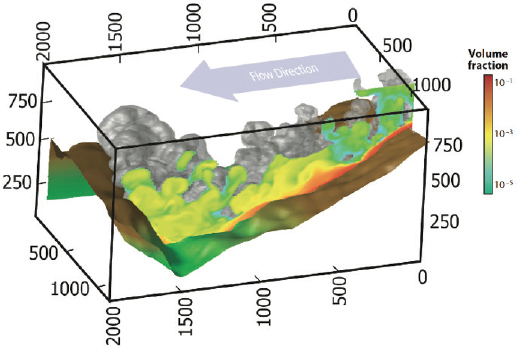
proach for combining observations and models in real time in an operational setting (e.g., ash dispersal forecasting for aviation safety). Models may not need to be complex if they capture the most important processes, although simplifications require testing against more comprehensive models and observations.
- Multiphase and multiphysics models improve scientific understanding of complex processes by invoking fewer assumptions and idealizations than reduced models ( Figure 1.10 ), but at the expense of increased complexity and computational demands. They also require additional components, such as a model for how magma in magma chambers and conduits deforms when stressed; a model for turbulence in pyroclastic density currents and plumes; terms that describe the thermal and mechanical exchange among gases, crystals, and particles; and a description of ash aggregation in eruption columns. A central challenge for multiphysics models is integrating small-scale processes with large-scale dynamics. Many of the models used in volcano science build on understanding developed in other science and engineering fields and for other ap-
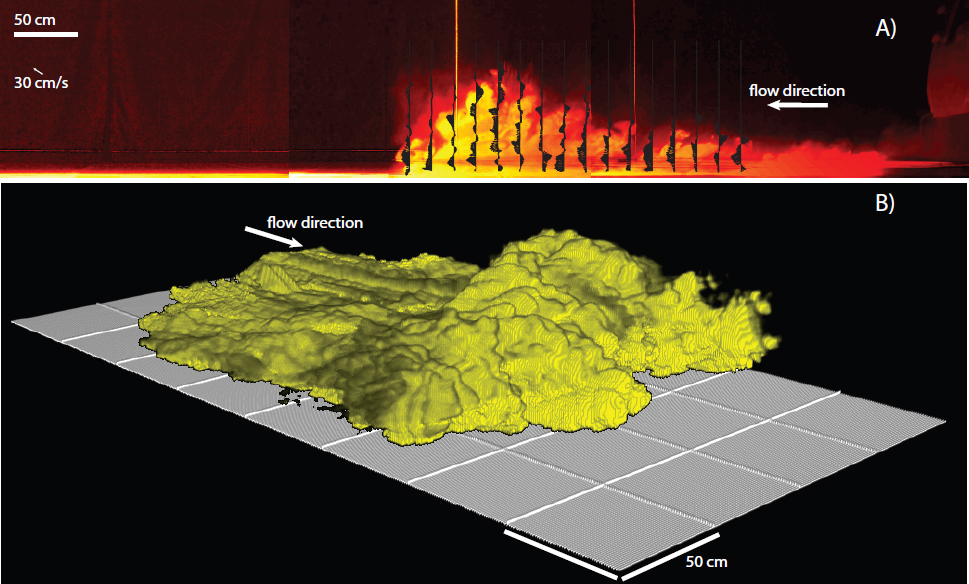
plications. Multiphysics and multiscale models benefit from rapidly expanding computational capabilities.
- Laboratory experiments simulate processes for which the geometry and physical and thermal processes and properties can be scaled ( Mader et al., 2004 ). Such experiments provide insights on fundamental processes, such as crystal dynamics in flowing magmas, entrainment in eruption columns, propagation of dikes, and sedimentation from pyroclastic density currents ( Figure 1.11 ). Experiments have also been used successfully to develop the subsystem models used in numerical simulations, and to validate computer simulations for known inputs and properties.
The great diversity of existing models reflects to a large extent the many interacting processes that operate in volcanic eruptions and the corresponding simplifying assumptions currently required to construct such models. The challenge in developing models is often highlighted in discrepancies between models and observations of natural systems. Nevertheless, eruption models reveal essential processes governing volcanic eruptions, and they provide a basis for interpreting measurements from prehistoric and active eruptions and for closing observational gaps. Mathematical models offer a guide for what observations will be most useful. They may also be used to make quantitative and testable predictions, supporting forecasting and hazard assessment.
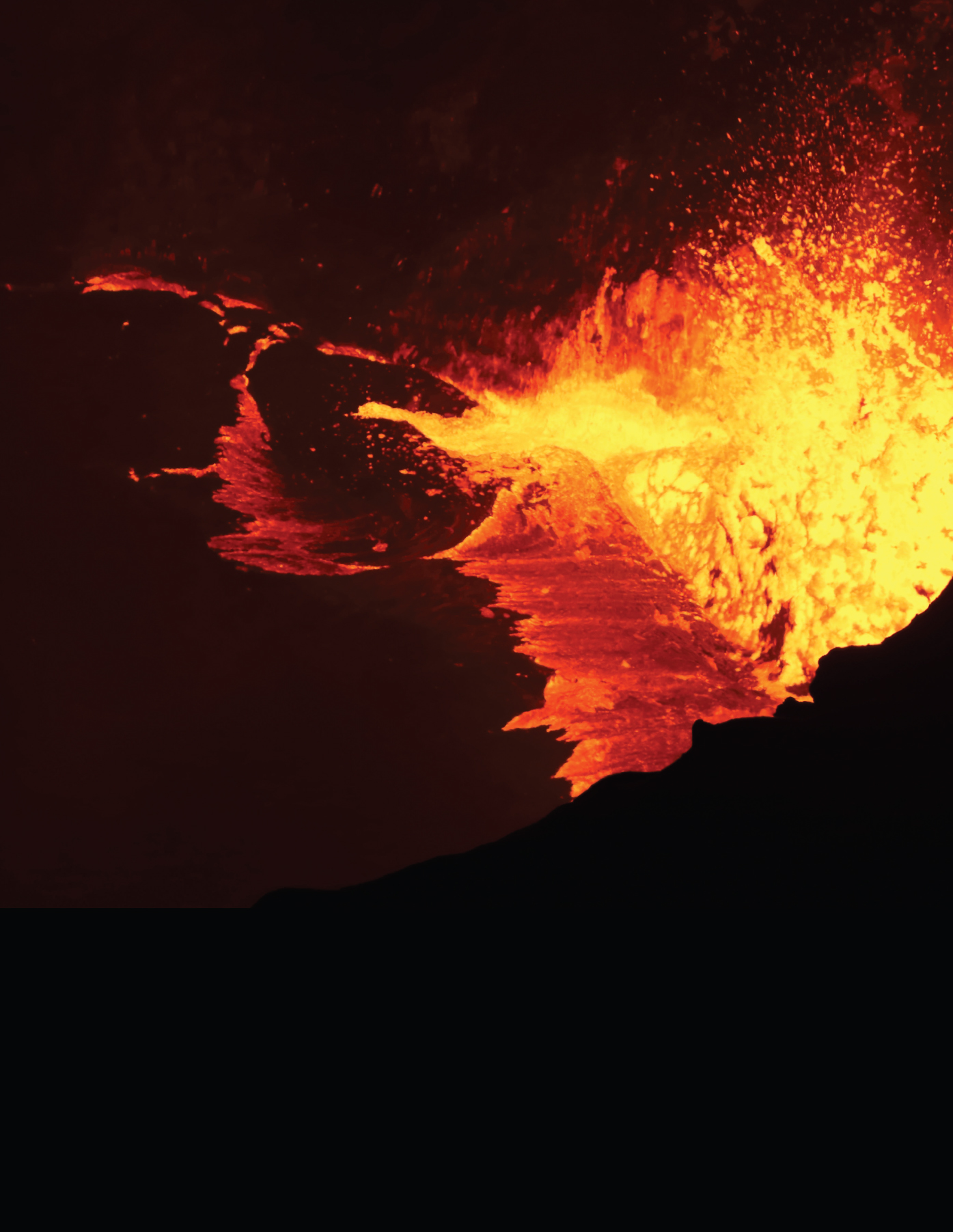
Volcanic eruptions are common, with more than 50 volcanic eruptions in the United States alone in the past 31 years. These eruptions can have devastating economic and social consequences, even at great distances from the volcano. Fortunately many eruptions are preceded by unrest that can be detected using ground, airborne, and spaceborne instruments. Data from these instruments, combined with basic understanding of how volcanoes work, form the basis for forecasting eruptions—where, when, how big, how long, and the consequences.
Accurate forecasts of the likelihood and magnitude of an eruption in a specified timeframe are rooted in a scientific understanding of the processes that govern the storage, ascent, and eruption of magma. Yet our understanding of volcanic systems is incomplete and biased by the limited number of volcanoes and eruption styles observed with advanced instrumentation. Volcanic Eruptions and Their Repose, Unrest, Precursors, and Timing identifies key science questions, research and observation priorities, and approaches for building a volcano science community capable of tackling them. This report presents goals for making major advances in volcano science.
Welcome to OpenBook!
You're looking at OpenBook, NAP.edu's online reading room since 1999. Based on feedback from you, our users, we've made some improvements that make it easier than ever to read thousands of publications on our website.
Do you want to take a quick tour of the OpenBook's features?
Show this book's table of contents , where you can jump to any chapter by name.
...or use these buttons to go back to the previous chapter or skip to the next one.
Jump up to the previous page or down to the next one. Also, you can type in a page number and press Enter to go directly to that page in the book.
Switch between the Original Pages , where you can read the report as it appeared in print, and Text Pages for the web version, where you can highlight and search the text.
To search the entire text of this book, type in your search term here and press Enter .
Share a link to this book page on your preferred social network or via email.
View our suggested citation for this chapter.
Ready to take your reading offline? Click here to buy this book in print or download it as a free PDF, if available.
Get Email Updates
Do you enjoy reading reports from the Academies online for free ? Sign up for email notifications and we'll let you know about new publications in your areas of interest when they're released.
It’s a wonderful world — and universe — out there.
Come explore with us!
Science News Explores
Let’s learn about volcanoes.
These vents into the Earth’s crust expose its melted heart
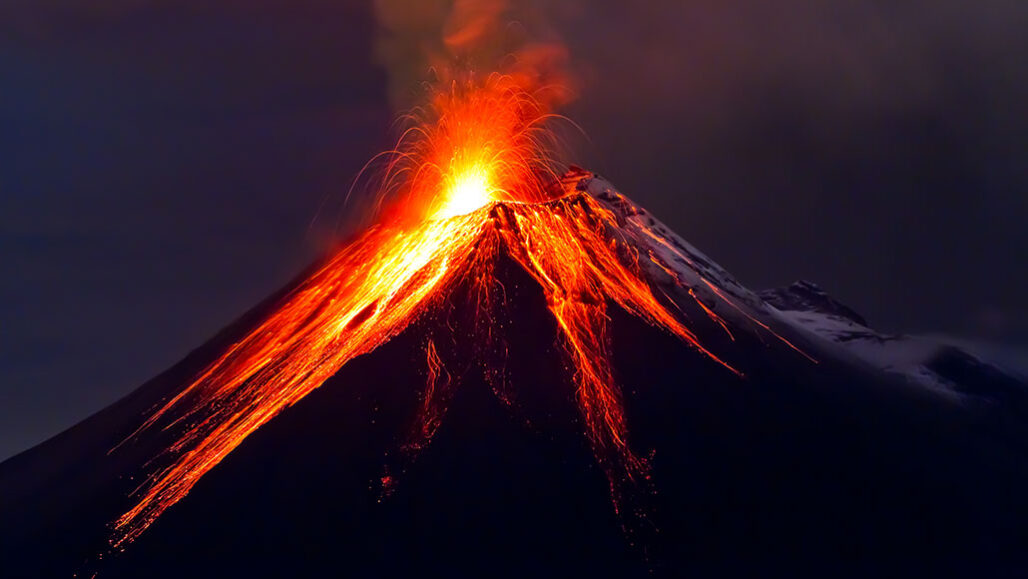
This is a volcano erupting in Ecuador.
pxhidalgo/iStock/Getty Images Plus
Share this:
- Google Classroom
By Bethany Brookshire
August 5, 2020 at 6:30 am
Walking around on the surface of the Earth every day, it’s easy to forget that a superhot pool of melted rock lies deep beneath our feet. Volcanoes are here to remind us.
Volcanoes are channels where melted rock, ash and gas can rise to the surface.
The Earth has around 1,500 potentially active volcanoes . Many of them are found along the edge of the Pacific Ocean, an area called the Ring of Fire. This is where many of the planet’s tectonic plates meet. These huge slabs, which make up Earth’s outer layer, crash into and slide over each other in extreme slow motion. When they do, they can raise up mountains, cause earthquakes — and open up volcanoes.
Huge volcanic explosions can wipe out ecosystems. They can build new land. And the biggest ones can change the Earth’s climate. The clouds of ash they throw up can cool the whole planet for years at a time. Some scientists thought that huge volcanic explosions might have cooled the planet and helped kill off the dinosaurs . But new evidence suggests that probably wasn’t true .
Volcanoes aren’t just on Earth. Other planets — such as Venus — might have them too.
Educators and Parents, Sign Up for The Cheat Sheet
Weekly updates to help you use Science News Explores in the learning environment
Thank you for signing up!
There was a problem signing you up.
Want to know more? We’ve got some stories to get you started:
After erupting, one volcano sings a unique ‘song’ : The low-frequency sound ebbs and flows with the whooshing of air inside the crater (7/25/2018) Readability: 8.6
Giant volcanoes lurk beneath Antarctic ice : The expanse of buried volcanoes raises questions about the future of the ice sheet (1/5/2018) Readability: 7.6
Study appears to rule out volcanic burps as causing dino die-offs : When toxic gases would have been spewed does not match when extinctions occurred (3/2/2020) Readability: 8.2
Explore more
Scientists Say: Ring of Fire
Explainer: The volcano basics
Explainer: Understanding plate tectonics
Cool Jobs: Getting to know volcanoes
Did rain put the Kilauea volcano’s lava-making into overdrive?
World’s biggest volcano is hiding under the sea
It’s a classic! The Natural History Museum in London, England offers a guide to making your own model volcano at home.
More Stories from Science News Explores on Earth

Many natural underground stores of freshwater are shrinking

Rampaging vines are slowly strangling tropical forests

This urban gardener is mimicking nature to create healthier plants
Explainer: Sprites, jets, ELVES and other storm-powered lights

Scientists Say: Carbon capture

9 things to know about lead’s health risks — and how to curb them

Health problems persist in Flint 10 years after water poisoning

Let’s learn about useful bacteria
Home — Essay Samples — Environment — Volcano — Exploring Volcanoes: From Formation to Societal Resilience
Exploring Volcanoes: from Formation to Societal Resilience
- Categories: Earth Volcano
About this sample

Words: 685 |
Updated: 29 March, 2024
Words: 685 | Pages: 2 | 4 min read
Table of contents
Introduction, volcano essay [100 words], volcano essay [150 words], volcano essay [200 words].

Cite this Essay
Let us write you an essay from scratch
- 450+ experts on 30 subjects ready to help
- Custom essay delivered in as few as 3 hours
Get high-quality help

Prof. Kifaru
Verified writer
- Expert in: Environment

+ 120 experts online
By clicking “Check Writers’ Offers”, you agree to our terms of service and privacy policy . We’ll occasionally send you promo and account related email
No need to pay just yet!
Related Essays
1 pages / 424 words
3 pages / 1502 words
4 pages / 2017 words
5 pages / 2459 words
Remember! This is just a sample.
You can get your custom paper by one of our expert writers.
121 writers online
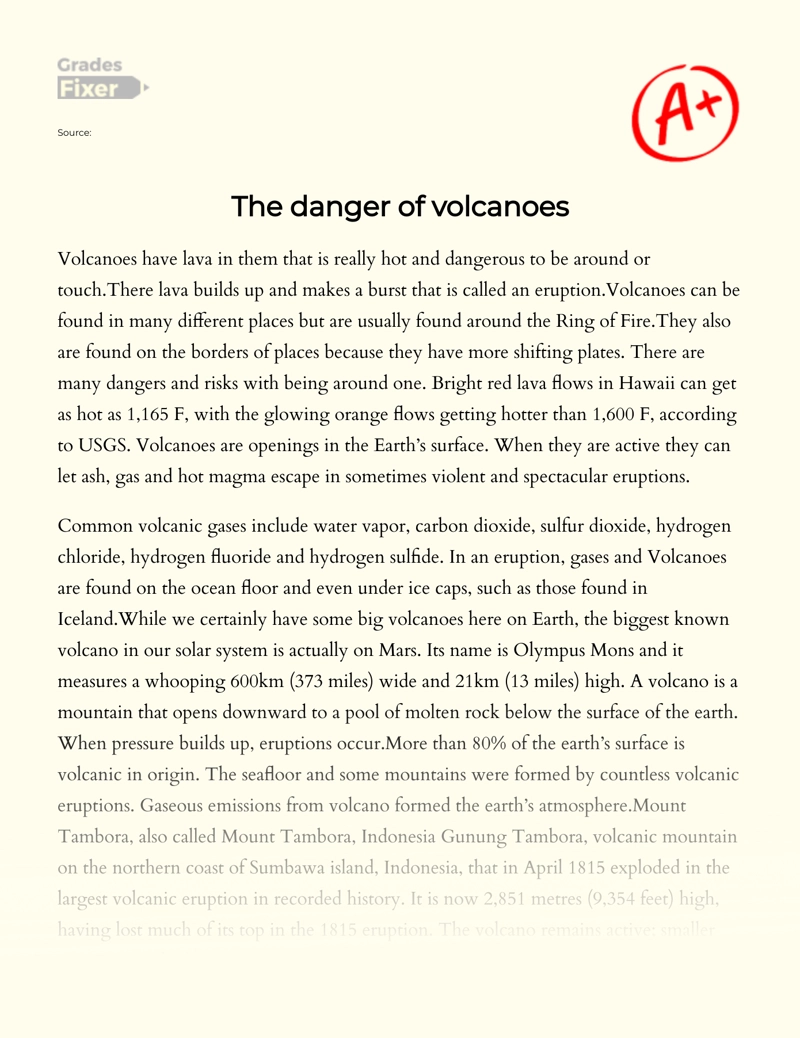
Still can’t find what you need?
Browse our vast selection of original essay samples, each expertly formatted and styled
Related Essays on Volcano
Volcanoes, nature's fiery spectacles, have long fascinated scientists and the curious alike. These geological wonders are not uniform; rather, they are categorized into distinct types, each with its unique characteristics and [...]
Composite volcanoes, also known as stratovolcanoes, are among the most fascinating geological phenomena on our planet. Their unique characteristics make them not only scientifically intriguing but also highly hazardous. In this [...]
The hydrophobic cotton surface is facilely fabricated by an easy novel method through adsorption of fluorosurfactant on the cotton surface and then polymerization of low-surface-energy fluoro monomer in the presence of an [...]
One of or maybe even the biggest threat to humanity now, but even more in the future, is climate change. Yet, not only we humans are endangered by climate change, but also all other species will have to live with the differences [...]
Forests, vast and diverse ecosystems that blanket our planet, play an essential role in the health of our environment and the survival of countless species. This essay delves into the various types of forests - coniferous, [...]
This essay is about the description and development of a new product that is yet to be introduced to the market. My idea is creating a potless water heater which will be a convenient and quick way of heating water. I argue that [...]
Related Topics
By clicking “Send”, you agree to our Terms of service and Privacy statement . We will occasionally send you account related emails.
Where do you want us to send this sample?
By clicking “Continue”, you agree to our terms of service and privacy policy.
Be careful. This essay is not unique
This essay was donated by a student and is likely to have been used and submitted before
Download this Sample
Free samples may contain mistakes and not unique parts
Sorry, we could not paraphrase this essay. Our professional writers can rewrite it and get you a unique paper.
Please check your inbox.
We can write you a custom essay that will follow your exact instructions and meet the deadlines. Let's fix your grades together!
Get Your Personalized Essay in 3 Hours or Less!
We use cookies to personalyze your web-site experience. By continuing we’ll assume you board with our cookie policy .
- Instructions Followed To The Letter
- Deadlines Met At Every Stage
- Unique And Plagiarism Free

IMAGES
VIDEO
COMMENTS
Here is a short paragraph on a volcano for children: A volcano can be defined as an opening in a planet through which lava, gases, and molten rock come out. Earthquake activity around a volcano can give plenty of insight into when it will erupt. The liquid inside a volcano is called magma (lava), which can harden.
5. Volcanoes Paper by Vanessa Strickland. "Beautiful and powerful, awe-inspiring and deadly, they are spectacular reminders of the dynamic forces that shape our planet.". Strickland's essay centers on volcanic formations, types, and studies, specifically Krakatoa's eruption in 1883.
Calbuco is a 6,570 foot high active stratovolcano located in Los Lagos, Chile. Its coordinates are 41°19′48″S 72°37′06″W. The closest populated area to the volcano is Puerto Varas which is located about 23.1 miles southwest of the Calbuco volcano as you can see in the google image below. 513 Words.
A volcano is an opening in a planet or moon's crust through which molten rock, hot gases, and other materials erupt. Volcanoes often form a hill or mountain as layers of rock and ash build up from repeated eruptions. Volcanoes are classified as active, dormant, or extinct. Active volcanoes have a recent history of eruptions; they are likely ...
Volcanoes, explained. These fiery peaks have belched up molten rock, hot ash, and gas since Earth formed billions of years ago. Volcanoes are Earth's geologic architects. They've created more than ...
The volcano inflated nearly 5 m before it erupted on October 22, 2005. SOURCE: Modified from Chadwick et al. (2006). Page 20 Share Cite. Suggested Citation:"1 Introduction." National Academies of Sciences, Engineering, and Medicine. 2017. Volcanic Eruptions and Their Repose, Unrest, Precursors, and Timing. Washington, DC: The National Academies ...
volcano, vent in the crust of Earth or another planet or satellite, from which issue eruptions of molten rock, hot rock fragments, and hot gases. A volcanic eruption is an awesome display of Earth's power. Yet, while eruptions are spectacular to watch, they can cause disastrous loss of life and property, especially in densely populated ...
A volcano is a mountain created through an opening on the Earth's surface after its eruption. Volcanoes are openings on the Earth's surface; the hole at the top of the volcano is known as a volcanic crater. A volcanic eruption is caused by the pressure which builds up in a gas that forms into magma. Under the surface of the Earth, magma is ...
Hawaii - A Volcano in the Sea. All the volcanoes in Hawaii are shield volcanoes. They are large and have shallow-sloping sides - almost like a warrior's shield. We will write. a custom essay specifically for you by our professional experts. 809 writers online. Learn More. Eruption of Mount Saint Helen Volcano.
After erupting, one volcano sings a unique 'song': The low-frequency sound ebbs and flows with the whooshing of air inside the crater (7/25/2018) Readability: 8.6. Giant volcanoes lurk beneath Antarctic ice: The expanse of buried volcanoes raises questions about the future of the ice sheet (1/5/2018) Readability: 7.6
Volcanic Hazards. hen Mount St. Helens exploded on May 18, 1980, there was no red hot lava flowing down from the top of the mountain. But there was an enormously powerful blast that permanently altered the landscape. This kind of explosive blast from a volcano is considered to be the most violent.
Essay # 7. World Distribution of Volcanoes: Like earthquakes, the spatial distribution of volcanoes over the globe is well marked and well understood because volcanoes are found in a well-defined belt or zone (fig. 9.3). Thus, the distributional pattern of volcanoes is zonal in character.
Essay # 1. Meaning of Volcanoes: Sometimes the molten rock, ash, steam and other gases find their way to the surface of the earth through some vents or openings. These ejected materials accumulate around the vent and give rise to a volcanic cone or a hill. The conical hill along with the vent is known as volcano.
Essay # 1. Definition of Volcanoes: A volcano is a vent or chimney which transfers molten rock known as magma from a depth to the Earth's surface. Magma erupting from a volcano is called lava and is the material which builds up the cone surrounding the vent. A volcano is active if it is erupting lava, releasing gas or generates seismic ...
Essay # 3. Formation of Volcanoes: The term volcano is used to mean both the opening in the earth's crust, i.e. the vent through which the eruption of magma occurs as well as the hill built- up by the erupted material. Volcanoes occur where the cracks in the earth's crust lead to the magma chamber.
The Danger of Volcanoes. Volcanoes have lava in them that is really hot and dangerous to be around or touch.There lava builds up and makes a burst that is called an eruption.Volcanoes can be found in many different places but are usually found around the Ring of Fire.They also are found on the borders of places because they have more shifting ...
Landslides. Deep sea volcanoes are known to cause massive landslides because of their massive cones (International Consortium on Landslides. General Assembly, 2005, p. 257). The main cause of landslides for deep sea volcanoes is caused by the very forces that created the volcanoes in the first place.
Paper Type: 1200 Word Essay Examples. Mount Pinatubo Volcano Story April 2nd 1991, Javier Nunez and Pablo Pinto were playing a friendly game of football on the outskirts of the town Angeles, where they lived, in the Philippines. All of a sudden hordes of tribesmen came running towards them.
Kilauea is one of five volcanoes that forms Hawaii. Kilauea is active, and the most active out of the five volcanoes. It has been erupting since 1983. Kilauea is approximately 300,000 and 600,000 years old. It is situated along Hawaii's south shore and is accepted to have arrived adrift level around 100,000 years prior.
At 9:08 p.m. a second eruption consisting of hot rocks came out violently from the summit of the volcano melting its ice cap and generating lava that streamed down in different lahars. These streams of lava and debris traveled at a velocity between 15 and 27 miles per hour covering a distance as high as 53 miles [12].
A volcano essay can be both informative and exciting for students studying them. Educating students about volcanoes through research and writing can help the...
Descriptive Essay Volcano. Ash plumes and steam rose into the bright blue sky as the underground earthquake shook the land and rattled windows all across the eighteen mile town. As the jet circled the island, in view of lovely beaches and emerald water, looming over this lush paradise was the screaming volcano.
The five-paragraph essay is one of the most common composition assignments out there, whether for high school or college students. Mastering the five-paragraph essay is doable, and here are some tips.... A five-paragraph essay on courage should contain an introduction with a thesis statement, three body paragraphs that support this thesis and a concluding paragraph that summarizes the essay ...